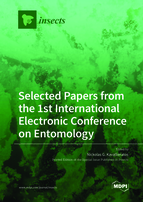Selected Papers from the 1st International Electronic Conference on Entomology
A special issue of Insects (ISSN 2075-4450).
Deadline for manuscript submissions: closed (31 March 2022) | Viewed by 75758
Special Issue Editor
Interests: stored-product protection; stored-product insect biology; chemical control; non-chemical control; trapping and sampling; taxonomy; aphid parasitoids; forest entomology
Special Issues, Collections and Topics in MDPI journals
Special Issue Information
Dear Colleagues,
This Special Issue is in cooperation with the 1st International Electronic Conference on Entomology (IECE), organized by Insects (Impact Factor 2.769) from 1 to 15 July 2021 on the MDPI Sciforum platform. We welcome submissions from participants of the conference, as well as those not participating.
All conference contributors, both to oral and poster sessions, are encouraged to submit a full paper related to their contribution to this Special Issue of Insects at https://www.mdpi.com/journal/insects, with a 20% discount on the Article Processing Charge (if accepted). Submission of a manuscript to Insects is independent of conference proceedings and will follow the standard peer-review process.
The Special Issue of Insects will maintain the topical subdivisions of the conference in the following eight fields:
• Systematics and Morphology
• Genetics and Genomics
• Biology, Behavior and Physiology
• Biodiversity, Ecology and Evolution
• Pest Management
• Forest and Urban Entomology
• Medical and Veterinary Entomology
• Apiculture and Pollinators
Submitted manuscripts to Insects should fulfill the following criteria:
(1) Title and Abstract should be substantially different with that of the conference paper, so that they can be differentiated in various databases.
(2) 50% new data should be added to make it a real and complete journal paper.
(3) The length of full manuscripts should accurately meet the publication standards of Insects. For more information, please visit: https://www.mdpi.com/journal/insects/instructions.
We look forward to your novel work.
Dr. Nickolas G. Kavallieratos
Guest Editor
Manuscript Submission Information
Manuscripts should be submitted online at www.mdpi.com by registering and logging in to this website. Once you are registered, click here to go to the submission form. Manuscripts can be submitted until the deadline. All submissions that pass pre-check are peer-reviewed. Accepted papers will be published continuously in the journal (as soon as accepted) and will be listed together on the special issue website. Research articles, review articles as well as short communications are invited. For planned papers, a title and short abstract (about 100 words) can be sent to the Editorial Office for announcement on this website.
Submitted manuscripts should not have been published previously, nor be under consideration for publication elsewhere (except conference proceedings papers). All manuscripts are thoroughly refereed through a single-blind peer-review process. A guide for authors and other relevant information for submission of manuscripts is available on the Instructions for Authors page. Insects is an international peer-reviewed open access monthly journal published by MDPI.
Please visit the Instructions for Authors page before submitting a manuscript. The Article Processing Charge (APC) for publication in this open access journal is 2600 CHF (Swiss Francs). Submitted papers should be well formatted and use good English. Authors may use MDPI's English editing service prior to publication or during author revisions.







